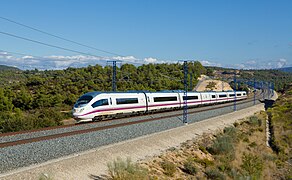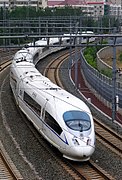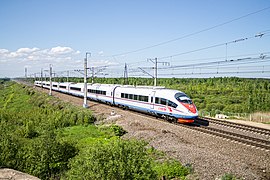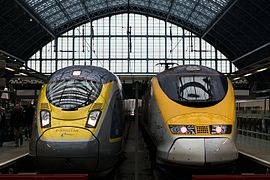Siemens Velaro
| Siemens Velaro | |||||||||||||||||||
|---|---|---|---|---|---|---|---|---|---|---|---|---|---|---|---|---|---|---|---|
 Velaro D in Stuttgart (Germany) | |||||||||||||||||||
| |||||||||||||||||||
| |||||||||||||||||||
| |||||||||||||||||||
| |||||||||||||||||||
Siemens Velaro is a family of high-speed electric multiple unit trains built by Siemens and used in Germany, Belgium, France, the United Kingdom, the Netherlands, Spain, China, Russia and Turkey. The Velaro is based on the ICE 3M/F high-speed trains manufactured by Siemens for the Deutsche Bahn (DB). The Deutsche Bahn were the first to order Siemens high speed trains; it ordered 13 of these units in 1994, the Nederlandse Spoorwegen (NS) 4 units. The trains were delivered in 1999 for service. The trains were labelled and marketed as the Velaro by their manufacturer, Siemens.
Siemens developed its Siemens Velaro based on the ICE 3M/F. Spain's RENFE was the first to order Velaro trains, known as Velaro E, for their AVE network. Wider versions were ordered by China for the Beijing-Tianjin high-speed rail (China Railways CRH3) and Russia for the Moscow–Saint Petersburg and the Saint Petersburg–Nizhny Novgorod routes (Velaro RUS/Сапсан). Since December 2013, the latest generation, Velaro D has been running in its home country, Germany.
In July 2006, a Siemens Velaro train-set (AVE S-103) reached 403.7 km/h (250.8 mph), which was the world record for railed and unmodified commercial service trainsets.[6]
Velaro E (AVE Class 103)[]
Velaro E is a version of the Velaro family used by RENFE for operations in Spain. In 2001, RENFE ordered sixteen Velaros[7] designated AVE Class 103. The order was later increased to a total of 26 trains. The trains serve the 621 km (386 mi) Barcelona–Madrid line at speeds up to 310 km/h (193 mph) for a travel time of 2 hrs 30 mins.
The first units were delivered in July 2005 and completed their first test runs in January 2006.
On 15 July 2006, a train achieved a top speed of 403.7 km/h (250.8 mph) between Guadalajara and Calatayud on the Madrid-Barcelona line. This is a Spanish record for railed vehicles. Until 3 December 2010 it was also a world record for unmodified commercial service trainsets, as the earlier TGV (world record of 574.8 km/h or 357.2 mph) and ICE records were achieved with specially modified and shortened trainsets, and the Shinkansen (443 km/h or 275 mph, 1996) record was for a test (non-commercial) trainset.
Velaro CN (CRH3C)[]
Velaro CRH3C is a Chinese version of the Velaro. In November 2005, China ordered 60 trains[7] for the Beijing–Tianjin Intercity Railway. The eight-car trains are very similar to Spain's Velaro E, but 300 mm (11.81 in) wider to fit in almost 50% more seats in a 2 plus 3 layout. In the CRH3C version, a 200-metre-long Velaro train will seat 600 passengers.[8] These trains were manufactured jointly by Siemens in Germany and CNR Tangshan in China. The first Chinese-built CRH3C was unveiled on 11 April 2008.[9]
CRH3C reached a top speed of 394.3 km/h (245.0 mph) during a test on the Beijing to Tianjin high-speed railway on 24 June 2008.[10]
Velaro RUS (RZD Sapsan)[]
Velaro RUS is part of the Velaro family built for Russia. On 19 May 2006 Siemens announced an order from Russian Railways for eight Velaro RUS high-speed trains including a 30-year service contract.[7] The contract is in total worth €600 million. The trains, connecting Moscow with Saint Petersburg, and later also Saint Petersburg and Nizhny Novgorod (the service was temporarily discontinued from 1 June 2015[11] till 1 March 2018[12]) at a speed of up to 250 km/h (155 mph), are based on the ICE3 train standard but with bodies widened by 33 cm (13 in) to 3.265 m (10 ft 8+1⁄2 in) to take advantage of Russia's standard loading gauge.[13] They are also built to the 1,520 mm (4 ft 11+27⁄32 in) Russian track gauge, unlike other Velaro EMUs, which are standard gauge.
Four of the trains are for both 3 kV DC and 25 kV 50 Hz AC operation. The total length of each ten-car train is 250 m (820 ft), carrying up to 600 passengers.
Development and construction were carried out at Erlangen and Krefeld in Germany. Single-voltage EVS1 (3 kV DC) trains entered passenger service at the end of 2009 on the Moscow–St Petersburg route,[14] and the dual-system EVS2 trains entered service on the Nizhniy Novgorod route in 2010.[15]
It set a record for the fastest train in Russia on 2 May 2009, travelling at 281 km/h (175 mph)[16] and on 7 May 2009, travelling at 290 km/h (180 mph).[17]
On 19 December 2011 an order for an additional 8 sets was signed in order to facilitate an increased number of services on existing lines and the expansion of new service elsewhere in the system.[18]
Velaro D (DB Class 407)[]
Velaro D is specifically designed for Deutsche Bahn international services from Germany. Designated DB's Class 407, it is designed to run at speeds up to 320 km/h (200 mph) and comply with Technical Specifications for Interoperability and enhanced crashworthiness requirements.[19] There are fire-proof equipment rooms and fire doors between cars. Velaro D is designed to be quieter and more reliable than the ICE 3 (Class 403/406).
The train is also expected to use up to 20% less energy than previous versions of ICE. This is achieved in part by improved body styling. It does not have the ICE3's panorama lounge where passengers in the end coaches can see the tracks over the driver's shoulder. The Class 407 has 460 seats: 111 in first class, 333 in second class and 16 in the bistro car. In total this is 37 more seats than the ICE 3, even though the seat pitch is unchanged. This is achieved by putting the traction equipment in compartments at either end of the train instead of hiding it behind panels the length of the train. Unlike all previous ICE versions, the passenger seating is all open-plan and there are no compartments.[20]
The eight-coach Class 407 trains can couple up and work with their Class 403 and Class 406 predecessors. Eight of the 16 bogies per train are powered, and there are four independent sets of traction equipment per train: if two of them break down, the train can still run. For full international flexibility across Europe, it can function on any of four voltages. The fleet will be based in Frankfurt.[20]
In December 2008 Deutsche Bahn signed a €500 million order for 15 trainsets.[21][22] The train's production stages were presented to the press in Krefeld on 28 April 2010,[23] and three completed cars were displayed by Siemens on 22 September 2010 at InnoTrans.[24] In June 2011, Deutsche Bahn ordered an additional Velaro D set (increasing the total to 16) in order to replace an ICE3MF set damaged in an accident in August 2010.[25]
Velaro D was meant to go into service starting December 2011[19] on services from Frankfurt to southern France via the new LGV Rhin-Rhône, and subsequently within Germany and on other international services to France, Belgium, Switzerland and the Netherlands.[20] Due to a series of delays in manufacturing and licensing no Velaro D trainsets were in service as of November 2012 and there was no schedule for their delivery. Only in December 2013 the first four trains delivered to DB were licensed for domestic operation as multiple units and started with passenger traffic. Four more trains are due to be delivered in spring 2014, whereas the remainder of eight trains shall be used for test runs in France and Belgium to gain type approval there.[26]
The specification of the Velaro D allows its access to the Channel Tunnel,[19] enabling DB to use it on the services it plans to operate from London to Amsterdam and Frankfurt.[27] Deutsche Bahn submitted safety documentation for the operation of Velaro D high speed trainsets through the Channel Tunnel to the Intergovernmental Commission in July 2011,[28] which in June 2013 granted a licence for passenger trains to DB.[29]
In 2012 and 2013, Siemens discussed with Deutsche Bahn the delivery of one more Velaro D set, free of charge, as compensation for the delivery and certification delays. This train was originally built for test purposes and features a different propulsion setup, utilizing permanent magnet AC synchronous motors as opposed to the traditional AC asynchronous motors. Siemens stated that this will allow a reduction in the number of propulsion units per train, while still maintaining train performance.[30][31]
Velaro e320 (Eurostar)[]

On 7 October 2010, it was reported that Eurostar had selected Siemens as preferred bidder to supply 10 Velaro e320[32] trainsets at a cost of €600 million (and a total investment of more than £700 million with the refurbishment of the existing fleet included)[33] to operate an expanded route network, including services from London to Cologne and Amsterdam.[34] These would be sixteen-car, 400-metre (1,312 ft) long trainsets built to meet current Channel Tunnel regulations, and would not be the same as the Velaro D sets which Deutsche Bahn propose to operate services between Germany and London.[34] The top speed will be 320 km/h (199 mph) and they will have 894-950 seats, unlike the current Eurostar fleet manufactured by the French Alstom, which has a top speed of 300 km/h (186 mph) and a seating capacity of 750. Total traction power will be rated at 16 MW (21,000 hp; 22,000 PS).[32][35][36] On the British system they are classified as Class 374 units.
Velaro TR (TCDD HT80000)[]
The Velaro TR is a Velaro D derived 8-car standard gauge high-speed train for the Turkish State Railways (TCDD). The eight cars, totalling a length of 200 m, can accommodate 519 passengers and reach a top speed of 300 km/h.[37][38][39] 25 kV 50 Hz AC power the train with a total of 8 MW.[37]
In 2013 TCDD concluded three contracts with Siemens for the acquisition of 17 units in total (1 unit for the first, 6 for the second and 10 for the last contract)[37][40] with a combined value of €685 million.[40] Furthermore, Siemens would provide 7 years of maintenance and cleaning, and also provide a simulator.[37] The Velaros are to be deployed on the Turkish high-speed railway network. The first Siemens Velaro (the only Velaro D type train of TCDD, code numbered HT80001) entered service on 23 May 2015 between Ankara-Konya.[39][41][42] The second Velaro of TCDD (which is the first Velaro TR type train, with the code number HT80101) arrived in Ankara on 17 February 2016.[39]
Unlike the traditional white - red - dark blue color scheme used on the TCDD HT65000 high-speed trains, a white - turquoise - grey color scheme has been selected for the livery of TCDD's Velaro trains.[41]
Velaro Novo[]
Velaro Novo is Siemens's concept for the next generation of high speed train.[43] It was announced in June 2018, and the first sets could be in service in 2023. Velaro Novo would be lighter and more efficient than previous designs, with a top speed of 360 km/h.[43][44]
Gallery[]

Series 103 train, Velaro E

Velaro CRH3C in China
A Chinese CRH3C unit

Siemens Velaro RUS EVS2

Siemens Velaro D at InnoTrans 2010, after handover of first train to DB.

Eurostar 320 (Class 374) near Sellindge, Kent, England.

A newer Eurostar E320 is seen next to an older Eurostar E300 (Class 373) at London St Pancras

A Turkish HT80000 at the ATG terminal in Ankara

A Turkish HT80000 unit seen here at InnoTrans 2016
See also[]
- Bombardier Zefiro
- Alstom AGV
- CAF Oaris
- List of high-speed trains
References[]
- ^ Brockmeyer, Ansgar; Gerdhard, Thomas; Lübben, Edzard; Reisner, Manfred; Bayrhof, Monika (6 June 2007). "High-speed trains: from power car to distributed traction". European Railway Review. 13 (3): 67–79. ISSN 1351-1599. OCLC 225912293.
- ^ "夯实基础求发展中国轨道交通产业喜结硕果——"2009年世界轨道交通发展研究会年会"在京召开". 世界轨道交通(World Railway) (12). 2009.
- ^ "High-Speed Trainset Velaro D (Class 407)" (PDF). Siemens.
- ^ "Erneuter Erfolg für die Hochgeschwindigkeitszüge von Siemens" (Press release) (in German). Siemens AG. 20 March 2009.
- ^ "CHINA High Speed Train The Key Technologyies and Maintenance System" (PDF). apta.com. Archived from the original (PDF) on 2013-01-23.
- ^ "First passengers travel on world record train Velaro". Erlangen, Germany: Siemens Transportation Systems. June 22, 2007. Retrieved 2013-12-26.
- ^ a b c Möller, Dietrich; Schlegel, Christian (2006). "Velaro - Weiterentwicklung des ICE 3 für den Weltmarkt" [Velaro - Further Development of the ICE 3 for Worldwide Use]. Elektrische Bahnen (in German). 104 (5): 258–263. ISSN 0013-5437. OCLC 2446655.
- ^ Brockmeyer, Ansgar; Reuß, Ernst; Wehrberger, Ralf (1 August 2007). "China's first 300 km/h trainsets are taking shape". Railway Gazette International. London. Retrieved 2009-08-05.
- ^ "Tangshan rolls out its first 350 km/h train". Railway Gazette International. London. 11 April 2008. Retrieved 2009-08-05.
- ^ "Velaro sets Chinese speed record". Railway Gazette International. London. 27 June 2008. Retrieved 2009-08-05.
- ^ "Strizh to replace Sapsan en route Nizhny Novgorod". lenta.ru. Moscow. 24 April 2015. Retrieved 2016-05-21.
- ^ "РЖД запустит "Сапсан" Петербург-Нижний Новгород с остановкой в Москве (in Russian). mir24.tv. 12 December 2017. Retrieved 8 February 2018.
- ^ Nazarov, Alexander; Nazarov, Oleg; Protze, Marion (1 November 2006). "Broad-gauge Velaro fleet relaunches Russia's high speed programme". Railway Gazette International. London. Retrieved 2009-08-05.
- ^ "Russian high speed train enters service". Railway Gazette International. London. 21 December 2009. Retrieved 2009-12-21.
- ^ "Sapsan reaches Nizhny Novgorod". Railway Gazette International. London. 2 August 2010.
- ^ "Sapsan claims Russian rail speed record". Railway Gazette International. London. 7 May 2009.
- ^ Электропоезд ЭВС (Сапсан) at Wikipedia in Russian (in Russian)
- ^ "Russian Railways orders eight more Sapsan trains". Railway Gazette International. 20 December 2011.
- ^ a b c "DB unveils next-generation ICE". Railway Gazette International. London. 29 April 2010. Retrieved 2010-07-26.
- ^ a b c Fender, Keith (December 2010). "Class 407 -- the fourth generation ICE". Modern Railways. London. pp. 72–73.
- ^ "Next ICE3s to have different axle dimensions". Railway Gazette International. London. 17 December 2008. Retrieved 2010-05-04.
- ^ "Siemens receives order over 15 high-speed trains from Deutsche Bahn" (Press release). Siemens. 17 December 2008. Retrieved 2008-12-27. Reference Number: I MO 200812.006-04.
- ^ New supertrain for Germany: Siemens introduces the Velaro D April 28, 2010
- ^ World premiere of Velaro D at Innotrans 2010 – first presentation of new high-speed train for Deutsche Bahn 22 September 2010
- ^ Smith, Kevin (June 2011). "DB and Siemens finally sign ICx contract". International Railway Journal. Falmouth. p. 4.
- ^ "EBA approves Velaro D high speed trains for domestic operation". Railway Gazette International. London. 23 December 2013.
- ^ Fender, Keith (December 2010). "DB unveils plans for London services". Modern Railways. London. pp. 68–69.
- ^ "DB submits Channel Tunnel ICE safety case". Railway Gazette International. London. 12 July 2011. Retrieved 2012-07-12.
- ^ Keith Barrow (June 14, 2013). "DB secures Channel Tunnel access". International Railway Journal. Retrieved December 26, 2013.
- ^ "Siemens soll der DB einen Superzug schenken". dmm Mobilitätsmanager (in German). Kitzingen, Germany: Verlag für Mobilität. 14 June 2013. Retrieved December 26, 2013.
- ^ "Verschieben sich ICE nach London wegen Vergesslichkeit?". dmm Mobilitätsmanager (in German). Kitzingen, Germany: Verlag für Mobilität. 2012-01-17. Retrieved 2013-12-26.
- ^ a b "320 km/h train order as Eurostar sets sights on expansion". Railway Gazette International. London. 7 October 2010.
- ^ "Eurostar unveils £700m train deal". BBC News. 7 October 2010.
- ^ a b "Eurostar picks Velaro to expand fleet". Railway Gazette International. London. 1 October 2010. Retrieved 2010-10-02.
- ^ "Carbon efficient Eurostar fleet going green". Silicon Republic. Dublin. 21 October 2010.
- ^ "High Speed Trainset Velaro Eurostar". Siemens. Archived from the original on July 23, 2015.
- ^ a b c d "Velaro Turkey: High-Speed Train for TCDD" (PDF). Siemens Mobility. Retrieved 2020-04-16.
- ^ "Velaro Turkey High-Speed Train". Siemens Mobility. Retrieved 2020-04-16.
- ^ a b c "Çok Yüksek Hızlı Tren Setlerinin İkincisi Geldi". TCDD. 2016-02-17. Retrieved 2016-06-22.
- ^ a b DVV Media UK. "TCDD orders 10 more Velaros". Railway Gazette. Retrieved 2015-06-20.
- ^ a b "TCDD's first Siemens Velaro train set at the Ankara Central Station". wordpress.com.
- ^ "TCDD advertisement with Siemens Velaro". tcdd.gov.tr.
- ^ a b "Siemens reveals Velaro Novo 360 km/h train concept". Railway Gazette International. 2018-06-13.
- ^ "Velaro Novo". Siemens Mobility Global.
External links[]
| Wikimedia Commons has media related to Siemens Velaro. |
- Velaro Background
- Velaro Sell Sheet; archived
- Updated Velaro Sell Sheet (2014)
- Velaro E specification sheet; download, archived
- Siemens Velaro RUS Sell Sheet
- Velaro CN Data Sheet; archived
- Velaro developmental history and technical details Siemens Page
- Velaro D Technical details Siemens Page
- More Velaro D Tech details (Includes TE curve graph)
- Velaro e320 technical specifications
- Interactive 360° virtual tour of the Velaro E
- Siemens Velaro
- High-speed trains
- Siemens products
- Proposed British rail vehicles
- Train-related introductions in 1999








